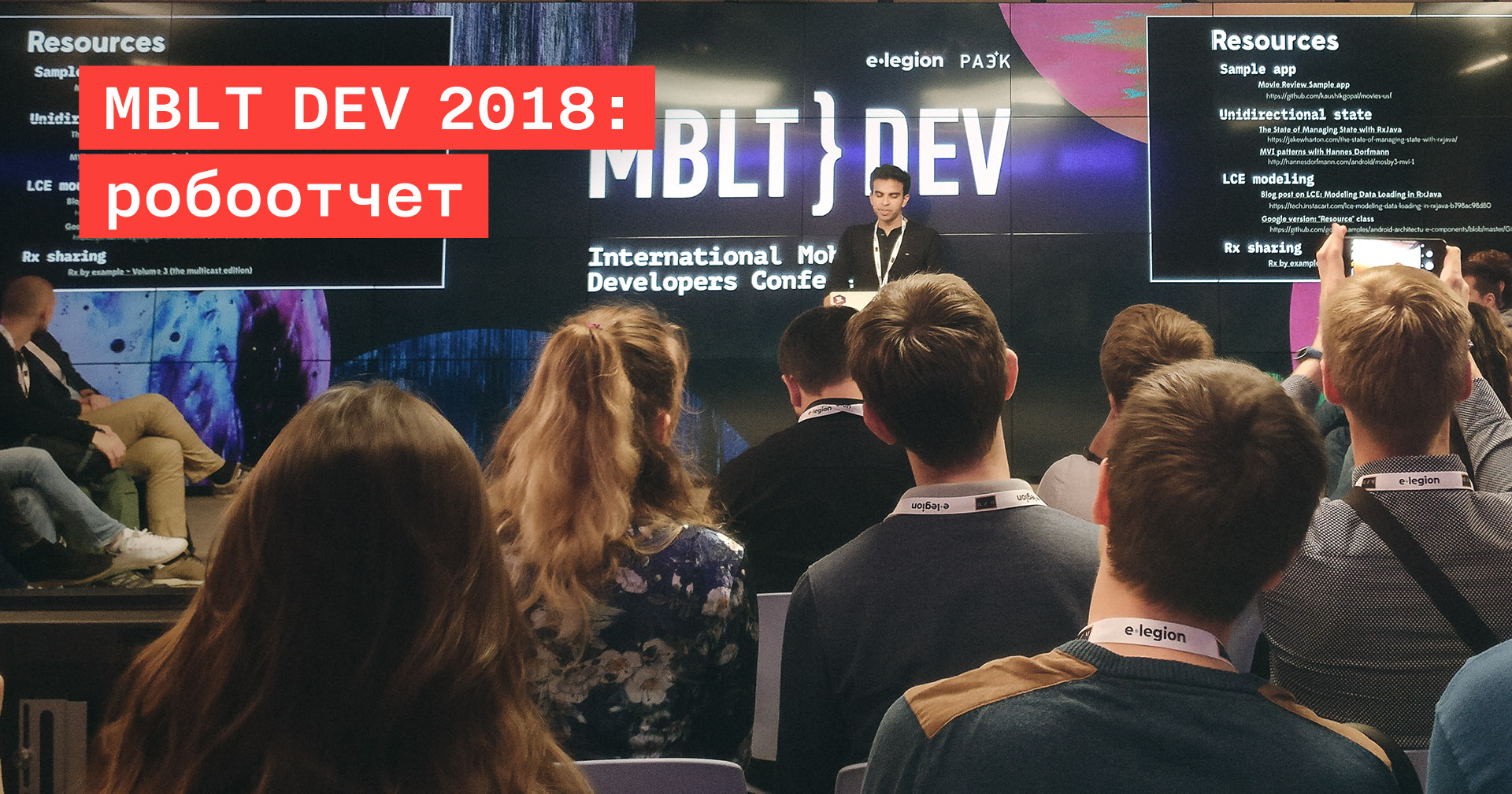MBLT DEV 2018: Robo Report

Android developer Pluzhnik and iOS developer Vasily Kotsyuba tell about how MBLT DEV 2018 went through, and which of the reports worth seeing in the recording.
Organizational Issues
The organizers are trying, and it is noticeable. The conference was a rare occasion when timing and schedule were respected, and there was enough time between performances to drink coffee and discuss reports with colleagues.
But it was not without problems. The presidential hall, where the speakers spoke, was too small. When all the seats on the very tightly arranged chairs were occupied, the doors to it were simply closed. Those who got inside were lucky, because they could ask questions to the speakers, and they were unlucky - because the ventilation coped with difficulty. Those who did not have time to take a seat were sent to watch the broadcast in the Glass Hall - there were refreshments, but in order to ask a question, the speaker had to be caught during the break.
')
The decision to set aside half an hour for lunch is also not a good one - there was a queue for food right there, so we decided to have lunch at a cafe. At 30 minutes, it is difficult to keep within this time, and when leaving the site, we had to pass the pass and, upon return, receive it again, presenting a passport. Inconvenient.
Reports: Android
In general, all reports of the Android part deserve attention. Special thanks to the English speakers who tried to be understood even by those whose English is far from perfect.
Kaushik Gopal from Instacart described his interesting vision of the application architecture, and more precisely of working with the view layer, in the report “Refactoring of a mobile application in UDF”. Developers familiar with the Flux architecture of web development have noticed that Kaushik suggested this approach to working with mobile applications.
Interesting was the report of Artem Rudovoy from Badoo on the reasons for creating a unified design system, the difficulties of implementing this concept and ways to solve them. If you feel that your project needs a unified approach to design, you should definitely see Artem’s report.
The Harshit Dwivedi report from Coding Blocks about the capabilities of the Firebase ML Kit library was also impressive. Using just a few lines of code, you can add text, face, barcode, object and image recognition features to your application. Moreover, most of these features are available even offline.
If all of the above is not enough for your tasks, you can create your own model on Firebase servers, provide training data, and use it later online or offline by adding to apk. It looks very interesting.
I remember the speech of Dmitry Melnikov from “TamTam” about the optimization of battery consumption. Particularly interesting was the data from studies describing battery consumption by hardware components of mobile platforms. For example, Wi-Fi consumes significantly more energy than 3G, and the use of hardware sensors of the device is practically “free”. The report contained many comparative comparative graphs of energy consumption, depending on the use cases of the device, showing the energy consumption of various components of the system. There were also materials on the power consumption of different versions of Android. I highly recommend reading this report to all those who want to optimize the performance of their application.
Reports: iOS
According to iOS, this year there were even more foreign speakers than local ones.
Of course, the most interesting was the report of Krzysztof Zabłocki with the loud name “iOS Application Architecture”. After an hour-long report, Krzysztof answered questions for 3 hours and gave advice in the recreation area.
If you have an application with localization for different languages, be sure to check out the John C. Fox report from Netflix “We are creating an application that is convenient for users all over the world.” In addition to useful tips on development, John definitely should learn to submit a report to a large audience.
For many, Alexey Borodkin from ROSBANK tried to solve the sore problem of building perfect development processes in the report “Product Ops: how to move from coding to creating products”.
General
Among the reports, of course, were not the most interesting. For example, we were perplexed when the stated topic was interesting, and the report itself was rather prosaic, and the problem described in it was finally solved by increasing the productivity of iron. At the end of the presentation, there were more questions on the topic than answers, and the speaker could not answer many seemingly obvious questions. In fairness, it is worth noting that the speaker himself proposed to discuss issues in the discussion area, where, perhaps, the minuses of the presentation were compensated by personal communication. Moreover, the speaker immediately lined up a queue of developers, whose questions remained unanswered.
Of course, the conference is, first of all, an opportunity to talk with colleagues, discuss problems and their solutions. Well, and win something from sponsors. And it’s definitely worth going to MBLT DEV.
Source: https://habr.com/ru/post/425671/
All Articles